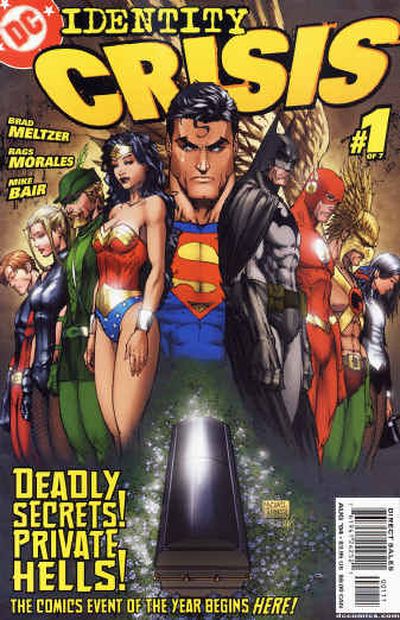Heroes of new comic book series not so super

Superheroes die all the time.
Superman kicked the bucket a few years ago but was back in no time soaring through the skies. Batman’s sidekick Robin also bit the dust once. Capes fall and refill again, a new story begins, and crimefighting goes on.
But a seven-part DC Comics series has become a best seller behind a more brutal premise: killing off a hero’s wife.
That is the central story of “Identity Crisis,” now reaching its fourth installment, which puts Batman, Superman, the Flash, Wonder Woman, Green Arrow and other notable characters through an emotional hell.
The story line has electrified readers by immersing the Man of Steel, the Caped Crusader and their fellow good guys in pain, guilt, anger, fear and realistic violence and consequences. Could these icons of righteousness sometimes commit horrible wrongs in pursuit of good?
Comics fans either adore “Identity Crisis,” or consider it heresy. Either way, it’s the No. 1 comic in the world right now.
The fourth installment is due in stores this week. The first issue, which came out at the beginning of summer, is sold out. Its cover featured all the major characters arrayed around a coffin, with Superman at the center, tears in his eyes – not the usual dramatic pose of a hero.
The story begins with a well-known woman from the DC Comics universe – someone who didn’t have any special powers – being raped and murdered: Sue Dibny, wife of Ralph Dibny, better known as the Elongated Man from the Justice League.
A few of the world’s most notable superheroes may have indirectly had a hand in Mrs. Dibny’s demise, or unjustly punished the wrong suspect – and find themselves agonizing over the responsibility.
“This is not an adventure. It’s a tragedy,” said “Identity Crisis” writer Brad Meltzer, the best-selling novelist of thrillers such as “The Millionaires” and “The Zero Game” and the co-creator of the new TV drama “Jack & Bobby.”
“It is taking the heroes and testing everything about them, putting them in difficulties and seeing if they come out the same way,” he said.
Both the appeal and the outrage of “Identity Crisis” is the way it alters the characters’ lore. It would be one thing to kill off the Elongated Man. It’s another to keep him alive – so grief-stricken that he literally cannot hold his body together when he breaks down.
DC editors say any future stories featuring the Elongated Man would have to reflect his newfound suffering. Similarly, the morally questionable investigative methods of Hawkman, the Green Arrow and the Flash in “Identity Crisis” will continue to reverberate throughout their own respective comic books.
“It has long-term ramifications for the next two years of storytelling, and we’ve already laid out one year,” said Dan DiDio, the DC Comics editor who’s overseeing “Identity Crisis.”
“It’s a tonal shift,” he said. “It’s an attitude and expectation. The DC universe is a very optimistic place. It’s a place you want to be living in. It’s a place where you know they’re building to a better future. They just have to work harder to get to that better future now, which is more reflective of the times we live in.”
Some comics fans are livid over the story. “Identity Crisis” artist Rags Morales said he has heard rumors about editors punching walls after reading the script, and about other writers and artists who have threatened never to work with DC again, although few have come out publicly.
Comics readers haven’t been as restrained. While the popularity of the books speaks for itself, there are strong detractors.
One recent posting on a DC fan Internet chat-room read: “Much as I loathe ‘Identity Crisis,’ I don’t see that it’s worth quitting DC over. The best way to combat the creeping ‘Identity Crisis’ syndrome in the DC universe is to do good comics that point the company in another direction.”
DiDio understands the reaction, noting that the story line “in some way shatters the perception of the icons as they existed in a more pure time.”
“But the newer readers, or the people looking for much stronger and multilayered storytelling, are embracing it,” he added. “This book has generated no apathy, that’s for sure.”
In some ways, this is also a response to the popularity of rival Marvel Comics, which has such characters as Spider-Man and the Hulk, whose appeal comes from battles with personal woes as well as supervillains.
DiDio didn’t want to go the “trouble with girlfriends” route, but he recognized that DC needed more emotional depth.
“I had the belief that our characters, being superheroes and cast in heroic roles, really have to be forced to examine what their desires and motivations are to be heroes,” he said. “Why do they have that need to put their lives at risk above the lives of their own family?”
Meltzer said he pitched the story with the idea that the death of the Elongated Man’s wife becomes secondary as the books progress.
“I said forget the death of the character, we’re going to test every character in the DC universe,” he said. “We’re going to test what they believe, what they stand for.
“We’re going to test whether Superman is as good as we think he is. We’re going to test whether Batman is, too. Yes, it will be in the context of this murder, but we’ll get so much more out of it.”